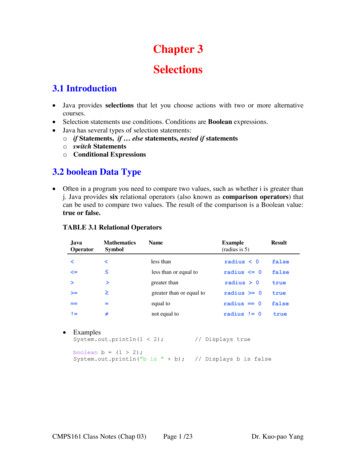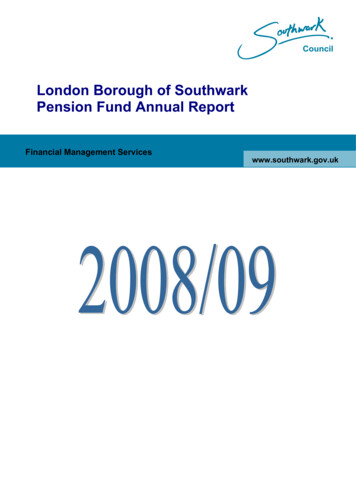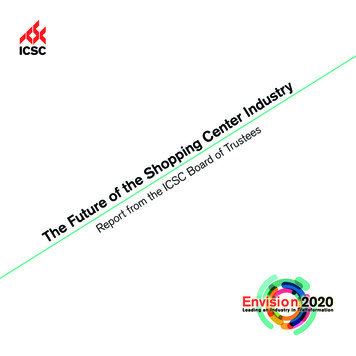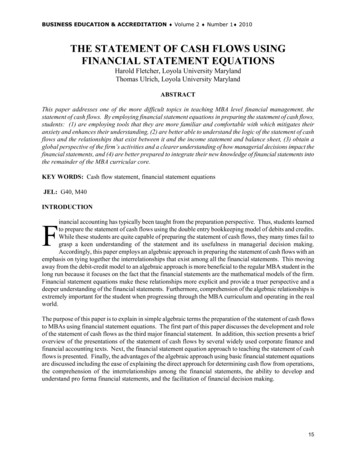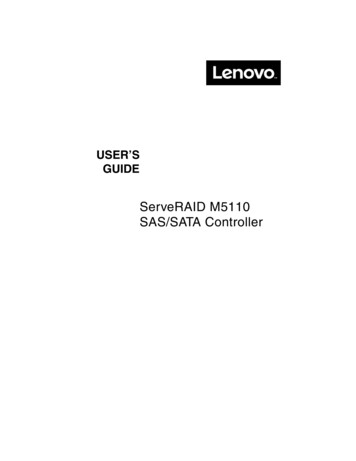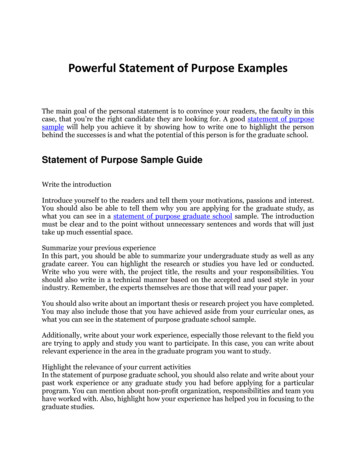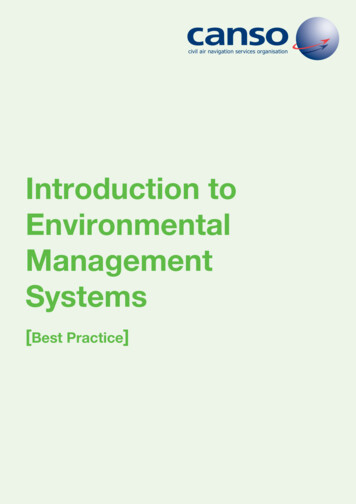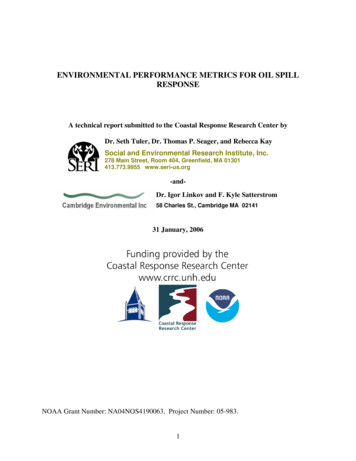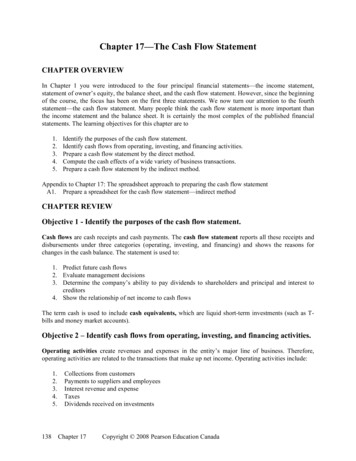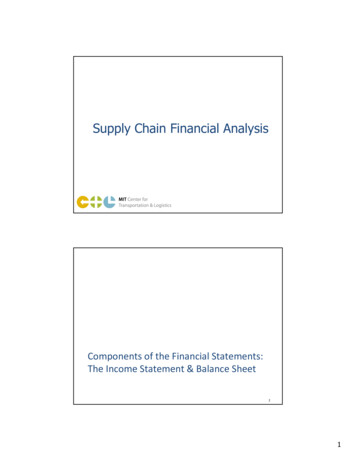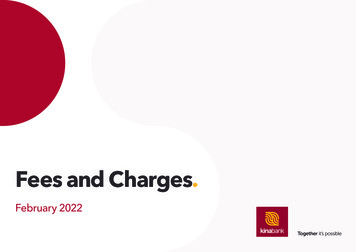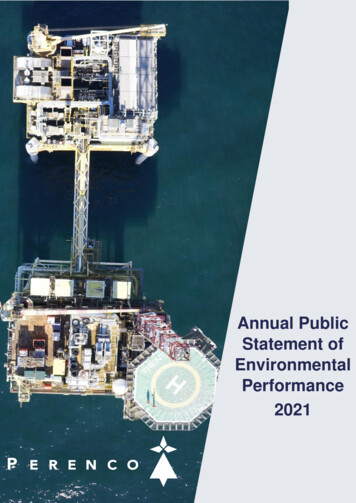
Transcription
Annual PublicStatement ofEnvironmentalPerformance2021
CONTENTSIntroduction. 1Production Hub Profiles . 2Environmental Management System . 4Operations and Environmental improvements . 6Environmental Performance . 8Atmospheric Emissions . 8Waste . 10Chemical Use and Discharge . 12Oil in Produced Water . 15Accidental Releases . 17Performance Against Environmental Objectives . 19PAGE i
INTRODUCTIONPERENCO UK SOUTHERN NORTH SEAPerenco UK Limited’s Southern North Sea business unit (PUK SNS) hasoperated in the SNS basin since 2003 and processes up to 15% of the UK'snational gas production.PUK SNS is the largest infrastructure owner within the United KingdomContinental Shelf (UKCS), acquiring assets in 2003 and 2012 from BP andfrom ExxonMobil in 2007. Today PUK SNS comprises 39 offshore platforms,182 producer wells, and a network of more than 2,400 km of pipelinesconnected to its 2 onshore gas terminals at Bacton on the Norfolk coast andDimlington near Humberside, Yorkshire.This report forms PUK SNS’s 2021 Public Statement, as required underOSPAR Recommendation 2003/5 and outlines the offshore environmentalperformance for UKCS operations during 2021. Bacton and Dimlingtononshore gas terminal operations are excluded from this report as they falloutside of the requirement.PAGE 1
PRODUCTION HUB PROFILESRAVENSPURN NORTHLocationDiscovery DateInfrastructureExportLocated within UKCS blocks 43/26, 43/27 and42/30.1983The Ravenspurn North production hub iscomprised of the Ravenspurn North mannedinstallation, ST2 and ST3 satellite installations andthe Johnston Subsea Development.Processed gas and condensate from theRavenspurn North and Johnston fields is exportedvia PL669 to the Cleeton Development, where itis co-mingled prior to export to Dimlington GasTerminal.CLEETONLocationDiscovery DateInfrastructureExportLocated within UKCS blocks 42/29, 47/3, 47/4,47/5, 47/9, 42/28 and 42/30.1976The Cleeton Hub is comprised of the mannedCleeton installation, satellite installationsRavenspurn South Alpha, Bravo and Charlie,Neptune, Minerva and subsea developmentsWhittle, Wollaston, Apollo, Mercury, Eris andCeres.Processed gas and condensate produced throughCleeton and associated infrastructure is exportedvia 36-inch PL447 to the Dimlington Gas Terminal.INDEFATIGABLE (INDE)LocationDiscovery DateInfrastructureExportLocated within UKCS Blocks 49/18, 49/23 and49/30.1966The Inde hub is comprised of the manned Inde23A installation, satellite installations Inde 18A,18B,23C,23D, 18A, 18B, Davy, Bessemer andsubsea developments North West Bell, DavyNorth and East.Gas and condensate produced through the Indehub is received on Inde 23A and exported viaPL22 to Leman 27B and onwards to the BactonGas Terminal via PL23.PAGE 2
WEST SOLELocationDiscovery DateInfrastructureExportLocated within UKCS blocks 48/6, 47/5 and 48/7.1965The West Sole hub is comprised of the partmanned West Sole Alpha installation, satelliteinstallations West Sole Bravo and Charlie, Hydeand Hoton and subsea tie back Newsham andSeven Seas.Processed gas and condensate produced throughthe West Sole Hub is exported onshore via PL145and PL28 to Dimlington Gas Terminal.LANCELOT AREA PIPELINESYSTEM (LAPS)LocationDiscovery DateInfrastructureExportLocated within UKCS Blocks 48/17 and 48/12.1986The LAPS hub is comprised of 4 satelliteinstallations Lancelot, Excalibur, Waveney andMalory.Comingled gas and condensate are exportedfrom the Lancelot installation to the Bacton GasTerminal via PL876.LEMANLocationDiscovery DateInfrastructureExportLocated within UKCS Block 49/27 and 53/02.1966The Leman hub is comprised of mannedinstallations Leman 27A and 27B, satelliteinstallations 27C, 27D, 27E, 27F, 27G, 27H, 27J andsubsea development Leman South.Gas and condensate produced through the Lemanhub is comingled with Inde production andexported to the Bacton Gas Terminal via PL23.TRENT AND TORSLocationDiscovery DateInfrastructureExportPAGE 3Located within UKCS Blocks 43/22, 43/24 and43/25.1991Trent, Kilmar and Garrow.Gas and condensate is exported to the Bacton GasTerminal via the PUK operated East Anglian Gasand Liquids Evacuation System (EAGLES) exportpipeline (PL253). These fields have been offlinesince June 2020 and are on the decommissioningpathway.
ENVIRONMENTAL MANAGEMENT SYSTEMPUK SNS implements an integrated Safety and Environmental ManagementSystem (SEMS) certified to ISO 14001:2015. Operating within SEMS ensuresthat activities are undertaken in accordance with PUK SNS policies andcomply with all relevant statutory provisions.SEMS comprises 15 key components which together provide a framework tosafe, environmentally responsible and reliable operations. Each of thecomponents set out standards which must be complied with, a set of actionsto be implemented, along with supporting information to provide guidanceon implementation.SEMSFrameworkFollowing a tri-annual recertification audit in September 2021 the PUK SNSSEMS remains accredited to the ISO 14001:2015 standard.PAGE 4
PUK SNS IS COMMITTED TO APPLYINGEFFECTIVE ENVIRONMENTAL MANAGEMENTCONTROLS across all onshore and offshore oiland gas activities to monitor, minimise andmitigate our environmental impacts, preventpollution, and protect marine and terrestrialenvironments, local communities, andstakeholders.PUK SNS WILL IMPROVE ENVIRONMENTAL PERFORMANCE THROUGH:Leadership and commitment from top management to promoteenvironmental protection.Continual improvement of our ISO14001 accredited environmentalmanagement system.Compliance with all applicable environmental legislation.Communication of our Environmental Policy and Objectives.Commitment of our staff, contractors and third parties to environmentalprocedures.Innovation to improve performance, extend field life and evaluateopportunities to participate in the future Energy Transition.Investigation and reporting of incidents thoroughly to prevent reoccurrence.Achieve annual environmental performance targets.Jonathan D. WhitePUK-SNS General Manager
OPERATIONS AND ENVIRONMENTALIMPROVEMENTSIn 2021, PUK SNS saw a continued high level of offshore activity, including well interventions,decommissioning and drilling projects.SUBSEA REPAIRSSubsea repair work was completed throughout 2021 on the Wollaston, Whittle, Mercury and Apollo fields.Wherever possible PUK SNS utilise opportunities to reduce waste through re-use. Below shows before andafter photos of the ex-Wollaston Subsea Control Module (SCM). This has been refurbished and re-tested andis now a serviceable spare. The refurbished SCM is now ready for rapid deployment anywhere in the SNS. Thisseries of module is now 20 years old and is just one example of PUK SNS employing this repurposing process.PAGE 6
DECOMMISSIONINGThe Amethyst A1D, B1D and C1D installations reached hydrocarbon free status during 2021, supportedby the Petrodec ERDA and HAEVA Jack-up Barges. Following completion of the hydrocarbon freecampaign, Amethyst C1D and B1D topsides were removed using Petrodec’s pioneering skiddingmethodology.BESSEMER SIMPLIFICATIONThe Bessemer simplification project included a well plug and abandonment and fabric maintenance tosimplify the installation’s operation, reduce emissions and allowed for continued gas production fromthe North West Bell subsea asset. As part of the simplification works a renewable energy package wasinstalled on the installation to power the navigational aids.SOUTHERN HUB AREA RATIONALISATION PROJECT(SHARP)SHARP continues to be a key project for PUK SNS and will result in significant reductions of CO2eemissions. During 2021, the new Leman 27BC jacket was permanently installed alongside the existingLeman 27B complex. The jacket has been modified to host the new gas compression and processingfacilities which will support the Southern Hub fields, with completion currently estimated for Q3/Q42022.PAGE 7
ENVIRONMENTAL PERFORMANCEPUK SNS monitored the atmospheric emissions, discharge of produced water and chemicals, disposal of waste and hydrocarbon and chemical spills tomeasure the Environmental Performance across PUK SNS assets throughout 2021.ATMOSPHERIC EMISSIONSCleeton, Ravenspurn North, Inde 23A, Leman 27A and Trent weresubject to control under the UK Emissions Trading Scheme (UKETS) (Amendment) Regulations (2020) during 2021 (formally theEU Emissions Trading Scheme). Each of these installations’combustion equipment exceeded a rated thermal input of 20MWth, triggering entry into the scheme.During 2021 34,321 tonnes CO2e was emitted through overall PUKSNS combustion activities. 64% of this total figure (21,974 tonnesCO2e) were verifiable under UK ETS, being attributed to Cleeton,Inde, Leman, Ravenspurn North and Trent.Figure 1 shows an overall reduction in CO2e emissions from 20172021. Emissions have reduced across PUK SNS assets with anoverall reduction of 70% between 2020 and 2021. This significantdecrease can primarily be attributed to the Trent platformremaining shut in throughout 2021, and the continued temporarycompression free ‘free flow’ status of the Inde and Leman hubs,as part of SHARP.PAGE 8Figure 1. 2017-2021 ETS Emissions by Installation300000250000Carbon Dioxide Emissions (tCO2e)Carbon Dioxide Equivalent (CO2e)Emissions (Emissions Trading 1Trent824119894699520,087348Ravenspurn North9557125651059799506895Leman 27A130583998291413551082945898Inde 1308714240
Intensity RatioSince 2019, PUK SNS has been required to publish detailed CO2e emissions data in the Directors’ Report submitted to Companies House, as definedby the Streamlined Energy and Carbon Reporting (SECR) guidelines. As part of this report PUK SNS have established an intensity ratio of SECR definedemissions converted to CO2e / exported gas (expressed as barrels of oil equivalent (BOE)), in line with the industry norm. The PUK SNS 2018 Base Yearintensity ratio was 14.43 kg CO2e / BOE, which has significantly decreased to 11.82 kg CO2e / BOE in 2020. The intensity ratio will continue to be usedas a measure of performance against CO2e emissions.Note: Both Onshore and Offshore PUK SNS operations fall within the SECR scope and the intensity ratio reflects the performance of the whole of PUK SNS.Figure 2. Tonnes of Gas Cold Vented by Hub in 202172Tonnes116Tonnes159TonnesVentingEmissions through cold venting increased from 35,381 tonnes of CO2e in2020 to 52,549 tonnes of CO2e during 2021. Venting figures have beenimpacted by several factors, including the PL24 pipeline rupture (whichreleased 24,340 tonnes of CO2e), increased accuracy in monitoring andrecording of venting operations and the recalculation of the Inde 23A purgerates.991 TonnesCleetonIndeLemanRavenspurn NorthPAGE 9
WASTEOperational WastePUK SNS successfully diverted all wastes from entering landfill in 2021*.This was achieved by working closely with our principle waste management contractor and proactively managing the waste generated as a result ofoperational activities, by application of the waste hierarchy.*Note: The only exception was asbestos and asbestos contaminated waste, of which 10.78 tonnes were disposed of via licenced landfills.900Quantity 40%245.230%200128.820%10000.0Recycling13.10.0Waste toEnergy0.00.0 0.6Incinerate7.8 0.0 2.9LandfillGroup II - GeneralGroup III - OtherFigure 3. Fate of Wastes by Waste ClassificationPAGE 108.8Other0.010%0%CleetonFateGroup I - Special33.7West SoleAlphaRecyclingTrentRavenspurn Leman 27ANorthWaste to EnergyIncinerateLandfillInde 23ALeman 27BOtherFigure 4. Fate of Wastes generated by Operational Platform
Other (Group III)0.22%Special (Group I)11.79%General (Group II)87.99%Decommissioning WasteA number of decommissioning projects were completedduring 2021. This included the hydrocarbon freecampaigns on the Amethyst A1D, B1D and C1Dinstallations, followed by the removal of the Amethyst C1Dand B1D topsides utilising the skidding methodology. C1Dand B1D topsides were subsequently transported to theNetherlands for recycling and recovery under anInternational Waste Shipment permit.2021 decommissioning projects were completed by thePetrodec ERDA and HAEVA Jack-up Barges.PUK SNS successfully diverted all general decommissioningwastes from entering landfill. The exception to this is thatsome hazardous wastes were disposed of via licencedlandfills by the dismantlement yard (0.05%).Figure 4.DecommissioningWaste by WasteClassificationIncinerate0.17%Waste to gure 5. Fate ofDecommissioningWastePAGE 11
CHEMICAL USE AND DISCHARGETOTALUSAGE (kg)TOTALDISCHARGE (kg)00B4200C00D58,72458,384EPOSES LITTLE ORNO RISK936,8019,493PURPLEHIGH 5762,073ANON-CHARMMODELCHEMICALCATEGORISATIONCHARM MODELCHEMICALCATEGORISATIONGOLDHIGH HAZARDLOW RISKTable 1. 2021 Chemical Use and Discharge Quantities According toOffshore Chemical Notification Scheme (OCNS) CategoriesPAGE 12The use and discharge of certain chemicals is subject to controlunder the Offshore Chemicals Regulations 2002 (as amended).This requires regulatory approval following an assessment ofthe predicted environmental impacts of any proposeddischarges. In addition, only chemicals that have beenregistered by the Centre for Environment, Fisheries andAquaculture Science (CEFAS) may be used.All chemical products used offshore undergo a hazardassessment, using the Chemical Hazard and Risk Management(CHARM) model, to calculate the ratio of Predicted EffectConcentration against No Effect Concentration (PEC:NEC). Thisis expressed as a Hazard Quotient (HQ), which is converted to acolour banding (Purple, Orange, Blue, White, Silver and Gold, inorder of environmental hazard level (highest to lowest)) andused to rank the product. Products that are not subject toCHARM modelling (i.e. inorganic substances, hydraulic fluids orchemicals used only in pipelines) are assigned an OffshoreChemical Notification Scheme (OCNS) grouping, A - E. Group Aincludes products considered to have the greatest potentialenvironmental hazard and Group E the least. As seen from Table1, PUK SNS strive to use chemicals which are as friendly to theenvironmental as possible.
Figure 6. ChemicalsUsed by perational ChemicalsD5.38%PUK SNS used a total of 1092 tonnes of chemicals in 2021, ofwhich 71 tonnes were discharged to sea in line with permitconditions. The usage of chemicals over the last 5 years hasseen an overall downward trend. This is due to a combinationof factors:E85.75% Decommissioning of platforms leading to subsequentreductions in chemical use. A reduction of continuous dosing of chemicals and amovement towards batch dosing methodology forchemicals used for hydrate control and corrosioninhibition.As shown in figures 6 and 7, PUK SNS strives to use chemicalsthat are as environmentally friendly as possible, with 99% ofthe chemicals used and discharged during 2021 classed asGold, Silver, E or D which are the two classifications of leastenvironmental risk under CHARM and OCNS.Figure 7. ChemicalsDischarged byOCNS 0%D81.55%PAGE 13
Gold1.1%Silver0.2%E98.7%Figure 8. ChemicalsDischarged byOCNS CategoriesDecommissioning and Project ChemicalsA total of 834 tonnes of chemicals were used fordecommissioning and project operations during 2021, ofwhich, 15 tonnes were discharged to sea (1.8%) in line withpermit conditions.During 2021 Amethyst (A1D, B1D and C1D) and Galahadhydrocarbon free campaigns were completed.100%The Bessemer platform wells were plugged and abandonedand simplification works undertaken to reduce operationalrequirements and overall emissions to the environment.100%Despite the high level of well intervention work undertakenduring 2021 the chemicals used were designated as eitherOCNS Gold (1.1%) or silver (0.2%) band or group E (98.7%).99%99%98%98%97%SilverGoldFigure 9. Percentage of Chemicals Used vs Discharged byOCNS CategoriesPAGE 14EUsedDischarged
OIL IN PRODUCED WATERThe discharge of oil is subject to control under the Oil Pollution Prevention and Control (OPPC) Regulations 2005 (as amended). After treatment, oil inproduced water was discharged from 5 of our operational assets in the SNS during 2021.Figure 10 shows that the oil discharged in 2021 has significantly decreased and is at the lowest levels since 2016. In previous years produced water hasbeen discharged from the Galahad, Trent, Waveney, Lancelot and Kilmar installations, however Galahad is now hydrocarbon free and the remaininginstallations have either been shut in or produced waters went to export, reducing the overall amount of produced water generated and dischargedduring 2021.The volume of produced water discharged from each asset during 2021 is presented in Figure 11 with the monthly flow-weighted average concentrationof oil in produced water against the consented limit.160,000.002,944.75140,000.00Produced Water 64.3920,000.000.00Produced Water (m3)Oil (Kg)2018201920202021Figure 10. Annual Produced Water and Oil Discharged 2016 -PAGE2021 15
Figure 11. 2021 Produced Water and Flow Weighted Oil Discharged by Asset30,00060Ravenspurn North - eRavenspurnNorthDischarged Produced Water (m3)PAGE 16Oil in Produced Water (mg/l)Produced Water Discharge (m3)25,000Ravenspurn North has historically discharged produced water whichwas far higher than the 30 mg/l permitted limit.Inde ACMaloryExcaliburAverage Annual Oil in Produced Water (mg/l)Consented LimitFollowing the implementation of an oil in produced watermanagement plan, operational trials and monitoring throughout2020 and 2021 a long-term solution was implemented and the hubsaverage oil in produced water reduced to 17.11 mg/l in 2021, from67.95 mg/l in 2019.Excalibur - ExceedancesSamples taken during an intervention visit in July 2021 returned ahigh oil in produced water result exceeding the 30mg/l permittedlimit. Excalibur was subsequently taken offline during its annualshutdown. During this shutdown remedial works were successfullycompleted on the production and test separators following which allsubsequent samples were below the permitted limit.
ACCIDENTAL RELEASESAs spills at sea can have consequences for the marine environment, PUK SNS works to minimise the risk whilst focusing on release prevention. ApprovedOil Pollution Emergency Plans (OPEPS) are implemented across all offshore assets, alongside regular drills and training undertaken to prevent accidentalreleases.The Oil Pollution Prevention and Control (OPPC) Regulations 2005 (as amended) applies to accidental hydrocarbon and chemical releases to sea, requiringPUK SNS to report all spills and conduct investigations to ascertain the cause and prevent reoccurrence.30 spills from PUK SNS assets were reported during 2021 and have been categorised by source in Figure 12. Three (3) releases were greater than 1 tonne;two (2) of which were releases of water soluble or PLONOR chemicals. The remaining 27 releases were 0.5 tonnes or below.Breaking ContainmentAsset DamageHose FailureControl SystemWellsDiesel System0246Figure 12. Accidental Releases during 2021 by Category810121416PAGE 17
PL24 RuptureAccidental Release CategoriesThe overall ratio of hydrocarbon to chemical releases is historicallylow and in previously years hydrocarbon releases have accounted forless than 10% of the overall volume. As per figure 13, this hasincreased in 2021 due to the PL24 pipeline rupture, which led to arelease of 12.19 tonnes of hydrocarbons.Hydrocarbon33%(12.56 tonnes)The PL24 pipeline is one of two gas export pipelines from the PUK SNS Leman and IndeFields in the Southern North Sea. It was installed in 1970 and runs from the Leman 27Binstallation to the Bacton onshore gas terminal.In February 2021 PL24 underwent catastrophic failure whilst being re-pressurised after a3-month period of isolation to facilitate project activity. The pipeline bifurcated local toa field joint girth weld, releasing 12.19 tonnes of condensate and 58.7 mmscf ofhydrocarbon gas.A salvage operation was completed to recover the bifurcated sections (see below images)and remove a snagging hazard for other marine users. Following formal investigation, itwas concluded that the failure was a result of a combination of factors, includingextreme, accelerated seabed movement, over the preceding months and storm forceweather conditions equal to 50-year significant wave height.Although large, the quantity of condensate released would not be expected to have anysignificant impact on the marine environment.Chemical67%(25.02 tonnes)PAGE 18Figure 13. AccidentalReleases Hydrocarbon vsChemicals
PERFORMANCE AGAINST ENVIRONMENTAL OBJECTIVESPUK SNS Senior Management annually reviews existing and agrees new environmental objectives in line with SEMS to help drive continual improvement.2021Business ObjectiveOverall ObjectiveMeasureProgressStatusCompletion of the installation of theBC compression platform and Inde/Leman manned hubs to NUI status.The BC compression platform wassuccessfully installed at Leman 27B during2021 and Leman 27B is now a mannedinstallation. The transition of Inde 23A andLeman 27A to NUI status has commencedand will be completed during 2022.OngoingIdentification ofbehavioural andoperational changes todrive efficiency/ limitemissions (CO2e) on theNorthern Hub mannedplatforms and terminals.Project identification to include ahopper of potential projects;examples include Trent compressorreplacement.Emissions reduction action plans have beendeveloped. These plans identify projects withthe potential to improve efficiency andemissions.CompletedEstablish anunderstanding of sourcesof methane emissions(both in design andfugitive) on mannedplatforms and terminals.NUI fugitive emissions calculation tobe re-assessed;Action plan developed for theNorthern Hub Assets;SHARP project fugitive emissionsincluded in the environmentalimpact reduction process.Emissions reduction action plans have beendeveloped.OngoingCompletion of theSouthern Hub AssetRationalisation Project(SHARP).Extending the field lifewhilst maximisingeconomic recovery in linewith the UK Net ZeroStrategyPAGE 1919PAGE
2022 ObjectivesBusiness ObjectiveExtending the field life whilstmaximising economic recoveryin line with the UK Net ZeroStrategyPAGEPAGE2020Overall ObjectiveAspectMeasureDevelopment of Perenco UK EmissionsReduction Strategy.Air EmissionsCompletion of 2022 Hub Emissions ReductionAction Plans.Delivery of commitments made in 2022Hub Emissions Reduction Action Plan.Air EmissionsCompletion of emission reduction activities detailedin the Emissions Reduction Action Plans.
This was achieved by working closely with our principle waste management contractor and proactively managing the waste generated as a result of operational activities, by application of the waste hierarchy. *Note: The only exception was asbestos and asbestos contaminated waste, of which 10.78 tonnes were disposed of via licenced landfills. 245 .
